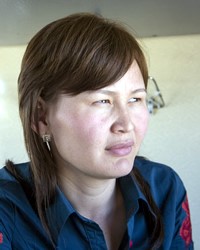Kazakh in Kazakhstan

Photo Source:
Petar Milošević - Wikimedia
Creative Commons
|
Send Joshua Project a map of this people group.
|
| People Name: | Kazakh |
| Country: | Kazakhstan |
| 10/40 Window: | Yes |
| Population: | 14,508,000 |
| World Population: | 17,966,900 |
| Primary Language: | Kazakh |
| Primary Religion: | Islam |
| Christian Adherents: | 0.50 % |
| Evangelicals: | 0.17 % |
| Scripture: | Complete Bible |
| Ministry Resources: | Yes |
| Jesus Film: | Yes |
| Audio Recordings: | Yes |
| People Cluster: | Kazakh |
| Affinity Bloc: | Turkic Peoples |
| Progress Level: |
|
Introduction / History
The Kazakhs, a Turkic people, are the second largest Muslim people group of Central Asia. In times past, they may have been the most influential of the various Central Asian ethnic groups. Most of the Kazakhs live in Kazakhstan. Large communities can also be found in Mongolia, Ukraine and Russia.
The Kazakhs developed a distinct ethnic identity in the late fifteenth and early sixteenth centuries. Several of their clans formed a federation that would provide mutual protection. As other clans joined the federation, its political influence began to take on an ethnic character. During the nineteenth century, the Russians acquired Central Asia through a steady process of annexation. They eventually claimed the entire territory of Kazakhstan. Tragically, about half of the Kazakh population was killed during the Russian Civil War of the 1920s and 1930s. During this time, many fled to China and Mongolia. They live in many countries although the majority remain in Kazakhstan.
What Are Their Lives Like?
Since the collapse of Soviet Communism in 1991, Kazakhs have been searching for their identity. Traditionally, they were nomadic shepherds; however, under Soviet rule, much of their land was seized and used for collective farming. As industry developed, their economy and culture became dependent entirely on the Russians. Today, however, there is a widespread movement to redevelop their own cultural identity. For example, some prefer to replace Russian with Kazakh as a trade language.
As nomadic shepherds, the Kazakhs lived in dome shaped felt tents called yurts. These portable dwellings could be taken down and moved from area to area as the shepherd found good land for his flocks.
During the days when Kazakhstan was part of the USSR, many Kazakhs were forced to move to cities and live in houses or small apartments. Most of these two or three room apartments have running water, though in some rural areas there is no hot water.
Kazakhs eat a variety of meat and dairy products. A popular Kazakh food is besbarmak, which is eaten with your hands. In fact, the Kazakhs have a strong tradition of eating with their hands rather than with utensils. It is made of noodles, potatoes, onions and mutton. Rice and bread are common staples. In the southern regions of Kazakhstan, fruit and vegetables grow in abundance. There the people enjoy eating grapes, melons and tomatoes. Kazakh apples are famous throughout Central Asia.
The foundation of Kazakh culture is hospitality, which always starts with a cup of tea. The host offers tea to any person who comes to his house. Guests must accept the kindness, or the host will be offended.
At home, women have domesticated duties. Ironically, women tend to excel over men as students and in the workplace, especially since there is a high alcoholic rate among men. Men are given preferential treatment for work promotions, though this might change in the future.
Like other Central Asian peoples, a favorite Kazakh sport is kokpar which means "fighting for a goat's carcass." Up to 1000 horseman will participate in this sport. Ice hockey and boxing are also popular sports among the Kazakhs.
Some Kazakhs have great wealth while others have very little. The wealthy own nice, new cars, dress well and throw lavish parties for their friends. The poor take public transportation, wear old clothes and must save money for months for a simple birthday party. Globalization will affect them as well. Will they keep Russian as a trade language, since that is a world-level language or use their local language?
What Are Their Beliefs?
Kazakhs embraced Islam during the sixteenth century and still consider themselves Muslim today. Changes in Kazakh society (mainly from a nomadic to a settled lifestyle) and an attempt by the Soviets to suppress religious freedoms have led the people to adopt Islam more closely. However, their Islamic practices have been combined with traditional folk religions.
Traditional Kazakh folk religion includes beliefs in spirits. They practice animism and ancestor worship. Animism is the belief that non-human objects have spirits. Ancestor worship involves praying and offering sacrifices to deceased ancestors. Today, Kazakhs continue to consult shamans (priests who cure the sick by magic, communicate with the spirits, and control events). They also practice various non-Islamic traditional rituals before and after marriage, at birth and at death.
What Are Their Needs?
Kazakhs are facing ecological catastrophe due to the mismanagement of natural resources. This has caused the near desolation of the Aral Sea and contamination of much of their drinking water. As a result, the infant mortality rate is very high. There is also a high rate of stillbirths and birth defects. Abortion is their main method of birth control. Most women have five or six abortions. Because Kazakhs value children, this creates a serious emotional battle for Kazakh parents.
Prayer Points
Pray for Christian workers to help with water purification projects.
Pray for dreams and vision of the victorious Lord for Kazakh family leaders.
Pray for a soon coming movement to Christ among Kazakhs that will lead to discipleship.
Pray for the Lord to give them a great harvest, leading them to understand God's goodness and power.